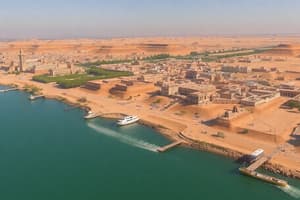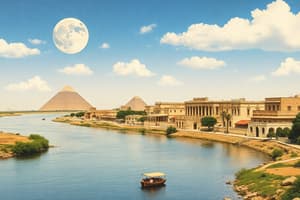Podcast
Questions and Answers
What is the significance of the Nile River's flooding as described in the content?
What is the significance of the Nile River's flooding as described in the content?
- It limited agricultural growth due to overflow.
- It primarily affected the economic stability of ancient Egypt.
- It created destructive floods that devastated cities.
- It was known as the 'miracle' and left fertile soil. (correct)
Which term refers to the triangular territory formed where the Nile splits?
Which term refers to the triangular territory formed where the Nile splits?
- Black Land
- Nile Delta (correct)
- Nile Valley
- Upper Egypt
What distinguishes Upper Egypt from Lower Egypt?
What distinguishes Upper Egypt from Lower Egypt?
- Upper Egypt refers to land upstream in the south. (correct)
- Lower Egypt is located where the Nile begins.
- Lower Egypt is characterized by deserts.
- Upper Egypt is north of the Nile Delta.
Why was the Nile River important for transportation in ancient Egypt?
Why was the Nile River important for transportation in ancient Egypt?
What is referred to as the “Black Land” by ancient Egyptians?
What is referred to as the “Black Land” by ancient Egyptians?
Flashcards are hidden until you start studying
Study Notes
The Nile River
- The Nile River is the longest river in the world, stretching over 4,000 miles (6,436 km) from its source in central Africa to its mouth at the Mediterranean Sea.
- The Nile splits into two branches before reaching the Mediterranean, forming a triangular region known as the Nile Delta.
- The Nile Delta is referred to as Lower Egypt, while the area upstream to the south is known as Upper Egypt.
- Ancient Egyptians called the annual flooding of the Nile a "miracle" due to its life-sustaining benefits.
- The Nile's summer floods, caused by heavy rains in central Africa, peaked in early autumn in Egypt, leaving behind a deposit of rich fertile soil that extended several miles on both sides of the river.
- The Egyptians named this fertile land the "Black Land," contrasting it with the surrounding barren "Red Land" deserts.
- The Nile's fertile land allowed Egyptian farmers to grow a surplus of food, contributing to Egypt's prosperity.
- The Nile River served as a unifying factor in ancient Egyptian history, facilitating transportation and communication throughout the land.
- Sailboats were propelled southward by north winds and northward by the Nile's current.
Studying That Suits You
Use AI to generate personalized quizzes and flashcards to suit your learning preferences.




